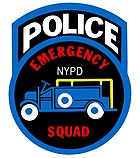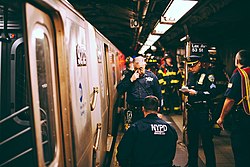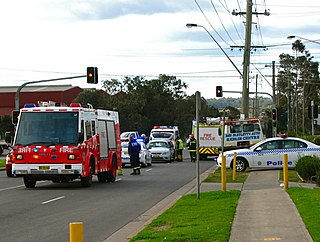
Emergency services and rescue services are organizations that ensure public safety, security, and health by addressing and resolving different emergencies. Some of these agencies exist solely for addressing certain types of emergencies, while others deal with ad hoc emergencies as part of their normal responsibilities. Many of these agencies engage in community awareness and prevention programs to help the public avoid, detect, and report emergencies effectively. Emergency services are often considered first responders, and typically have dedicated emergency vehicles.
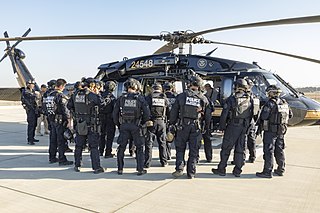
In the United States, a SWAT team is a generic term for a police tactical unit.

The New York City Fire Department, officially the Fire Department of the City of New York (FDNY) is the full-service fire department of New York City, serving all five boroughs. The FDNY is responsible for fire suppression and fire prevention, and is a major provider of EMS services in New York City. Beyond fire suppression and EMS, the FDNY is responsible for a broad range of services, including technical rescue, CBRN defense, and structural collapse response and analysis.

A police car is a ground vehicle used by police and law enforcement for transportation during patrols and responses to calls for service. A type of emergency vehicle, police cars are used by police officers to patrol a beat, quickly reach incident scenes, and transport and temporarily detain suspects, all while establishing a police presence and providing visible crime deterrence.
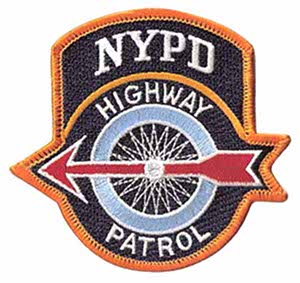
The Highway Patrol are specialized units part of the Highway District with the Transportation Bureau of the New York City Police Department. The Highway Patrol is primarily responsible for patrolling and maintaining traffic safety on limited-access highways within New York City. The Highway Patrol's other duties and roles include accident investigations, advanced driver and radar/laser speed enforcement training for NYPD officers, field sobriety testing at the various testing locations in each Patrol Borough, dignitary and parade escorts, hazardous material and truck traffic enforcement, anti-drag racing programs, and anti-terrorist checkpoints at key bridges and intersections in the city.
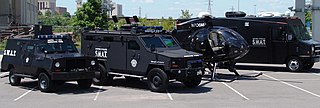
A SWAT vehicle, police armored vehicle, or police rescue vehicle is a non-military armored vehicle used by police tactical units to respond to incidents. They are most often in configurations similar to military light utility vehicles, infantry mobility vehicles, or armoured personnel carriers. They are generally designed to have armor that can sufficiently block high-caliber rounds, space to carry the unit's equipment, and sufficient passenger seating; some also allow for additional personnel to hang onto the side of the vehicle in transit.
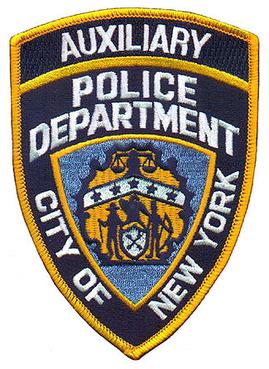
The New York City Police Department Auxiliary Police is a volunteer reserve police force which is a subdivision of the Patrol Services Bureau of the New York City Police Department. Auxiliary Police Officers assist the NYPD with uniformed patrols, providing traffic control, crowd control, and other services during major events.

Special Tasks and Rescue Group is the Police Tactical Group of the South Australia Police.
The State Protection Group (SPG) is part of the Counter Terrorism & Special Tactics Command of the New South Wales Police Force and was established in 1991 to deal with extraordinary policing responses. The SPG directly supports police in high-risk incidents such as sieges with specialised tactical, negotiation, intelligence and command-support services. The unit also provides rescue and bomb disposal support, canine policing, and armoury services.
Special Emergency Response Team (SERT) is the Police Tactical Group of the Queensland Police Service (QPS) and also provides a high angle rescue response. SERT provides the QPS with the ability to respond to high risk situations incidents statewide. SERT is based in Brisbane and Cairns to ensure that specialists capabilities are available to support police at any location in Queensland.

The Port Authority of New York and New Jersey Police Department, or Port Authority Police Department (PAPD), is a law enforcement agency in New York and New Jersey, the duties of which are to protect and to enforce state and city laws at all the facilities, owned or operated by the Port Authority of New York and New Jersey (PANYNJ), the bi-state agency running airports, seaports, and many bridges and tunnels within the Port of New York and New Jersey. Additionally, the PAPD is responsible for other PANYNJ properties including three bus terminals, the World Trade Center in Lower Manhattan, and the PATH train system. The PAPD is the largest transit-related police force in the United States.
The New York City Police Department's Medal for Valor is the department's third highest medal. It is conferred upon police officers for acts of outstanding personal bravery intelligently performed in the line of duty at imminent personal hazard to life under circumstances evincing a disregard for personal consequences.
An emergency service unit (ESU), alternatively emergency service detail (ESD) or emergency service squad (ESS), is a type of unit within an emergency service, usually police, that is capable of responding to and handling a broader or more specific range of emergencies and calls for service than regular units within their organization, such as rescue, emergency management, and mass casualty incidents. They are similar to police tactical units, fire department technical rescue, and incident response teams in other emergency services and organizations, and often have similar or overlapping roles; the term is also used synonymously for these units, or as a catch-all for units that combine multiple disciplines and roles under one banner.
Until July 2012 the Specialist Response and Security Team (SRS) was a Police Tactical Group of the Australian Federal Police (AFP) having responsibility for tactical and specialist operations within the Australian Capital Territory. The Operational Response Group (ORG) had responsibility for AFP National and International tactical operations. In July 2012 the SRS was merged with the ORG to create the Specialist Response Group.
The New Jersey Transit Police Department (NJTPD) is a transit police agency of the New Jersey Transit Corporation in the state of New Jersey. As provided by NJS Title 27:25-15.1, New Jersey Transit Police Officers have "general authority, without limitation, to exercise police powers and duties, as provided by law for police officers and law enforcement officers, in all criminal and traffic matters at all times throughout the State and, in addition, to enforce such rules and regulations as the NJ Transit Corporation shall adopt and deem appropriate."

The New York City Police Department (NYPD) is structured into numerous bureaus and units. As a whole, the NYPD is headed by the Police Commissioner, a civilian administrator appointed by the Mayor, with the senior sworn uniformed officer of the service titled "Chief of Department". The Police Commissioner appoints the First Deputy Commissioner as the department's second-in-command and the Chief of Department as the department's highest ranking uniformed officer. The commissioner also appoints a number of deputy and assistant commissioners who do not have operational command and are solely for support and administrative function. The department is divided into twenty bureaus, six of which are enforcement bureaus. Each enforcement bureau is further subdivided into sections, divisions, and units, and into patrol boroughs, precincts, and detective squads. Each bureau is commanded by a bureau chief. There are also a number of specialized units that are not part of any of the bureaus and report to the Chief of the Department.

The Detective Bureau is one of 14 bureaus within the New York City Police Department and is headed by the three-star Chief of Detectives. The Detective Squad was formed in 1857 with the Detective Bureau later formed in 1882.

The Baltimore City Fire Department (BCFD) provides fire protection and emergency medical services to the city of Baltimore, Maryland, United States. Founded in 1797 and established in 1859, the Baltimore City Fire Department covers an area of 81 square miles (210 km2) of land and 11 square miles (28 km2) of water, with a resident population of over 640,000 and a daytime population of over 1,000,000. The BCFD responds to approximately 235,000 emergency calls annually. There are two International Association of Fire Fighters (IAFF) locals; IAFF 734 for firefighters and IAFF 964 for officers.

The Lenco BearCat is a wheeled SWAT vehicle designed for military and law enforcement use. It is in use by numerous military forces and law enforcement agencies around the world.

The New York Police Department's Strategic Response Group (SRG) is a unit of the New York City Police Department (NYPD) formed in 2015 for all counter-terrorism and the policing of political protests.
